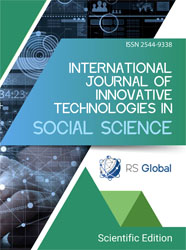THE MAIN FORMATS OF INTERNATIONAL COOPERATION WITHIN THE FRAMEWORK OF MULTELATERAL DIPLOMACY
Abstract
A comprehensive study of the formation and development of the institute of multilateral diplomacy, as well as the mechanisms and methods of its implementation, is becoming particularly relevant at the present stage. Due to the increasing complexity of global political processes and the formation of a new world order, many scientists, public figures and politicians today dispute the value of multilateralism, which negatively affects the development of its institutions. The purpose of this article is to study multilateral diplomacy in the context of revealing the main formats of international interaction within the framework of this type of diplomacy. In theory, multilateral diplomacy is guided by some key principles of international order. In practice, multilateral diplomacy is the main instrument of cooperation in the search for agreed solutions, as well as the implementation of the political goals of certain participating States. This kind of diplomacy requires a serious modernization of diplomatic structures, tools and methods.
References
Zonova, T. (2003). The modern model of diplomacy: Origins and development prospects [Sovremennaya model' diplomatii: Istoki stanovleniya i perspektivy razvitiya]. Moscow: Russian Political Encyclopedia. 336 p. ISBN: 5-8243-0384-3
Kunina, I. (2019). Multilateral diplomacy in the context of modern international political processes [Mnogostoronnaya diplomatiya v kontekste sovremennykh mezhdunarodno-politicheskikh protsessov]. In Topical Issues of International Relations, Republican Scientific Conference Proceedings, Baku, October 25, p. 580.
Lebedeva, M. (2020). The new world order: Parameters and possible outlines. Polis. Political Studies, 29(4), 24–35. https://doi.org/10.17976/jpps/2020.04.03
Nazariya, S., & Pynzar, S. (2006). Multilateral diplomacy yesterday and today: Theoretical approaches [Mnogostoronnaya diplomatiya vchera i segodnya: Teoreticheskie podkhody]. Anuar STINTIFIC, IV, 68–74. https://ibn.idsi.md/sites/default/files/imag_file/Mnogostoronniaia%20diplomatia%20vcera%20i%20segodnea_teoreticeskie%20podhodi.pdf
Oleandrov, V. (2013). Multilateral diplomacy [Mnogostoronnaya diplomatiya]. Law and Governance of the 21st Century, 2(27), 69–76. http://pravo.mgimo.ru/sites/default/files/pdf/11_oleandrovv.pdf
Feldman, D. (2011). The state in the network of international political interaction [Gosudarstvo v seti mezhdunarodno-politicheskogo vzaimodeystviya]. Comparative Politics, 4, 27–35. https://doi.org/10.18611/2221-3279-2011-2-4(6)-27-34
Barstone, R. (2019). Modern diplomacy. New York. 534 p. ISBN: 1138576336
Berridge, G. R., & James, A. (2001). A dictionary of diplomacy. Hampshire & New York. 160 p.
Bonciong, A. (1997). Diplomatic Law [Drept diplomatic]. Bucharest: Paideia Publishing. 267 p. ISBN: 973-9131-72-7
Börzel, T. (1998). Organizing Babylon: On the different conceptions of policy network. Public Administration, 76(2), 253–273. https://doi.org/10.1111/1467-9299.00100
Hanson, F. (2011). The new public diplomacy. Lowy Institute. https://www.files.ethz.ch/isn/132392/Hanson,%20The%20new%20public%20diplomacy.pdf
Mahbubani, K. (2020). The Asian 21st Century, China and Globalization. https://doi.org/10.1007/978-981-16-6811-1_43 https://www.researchgate.net/publication/357503841_Multilateral_Diplomacy
Metzl, J. (2001). Network diplomacy. Georgetown Journal of International Affairs, 2(1), 77–87. http://carnegieendowment.org/2001/04/01/network-diplomacy/dv3
Cooper, A. F., Heine, J., & Thakur, R. (Eds.). (2013). The Oxford Handbook of Modern Diplomacy. Oxford University Press. 766 p. ISBN: 978-0-19-958886-2
Views:
387
Downloads:
375
Copyright (c) 2025 Kunina Irina

This work is licensed under a Creative Commons Attribution 4.0 International License.
All articles are published in open-access and licensed under a Creative Commons Attribution 4.0 International License (CC BY 4.0). Hence, authors retain copyright to the content of the articles.
CC BY 4.0 License allows content to be copied, adapted, displayed, distributed, re-published or otherwise re-used for any purpose including for adaptation and commercial use provided the content is attributed.











